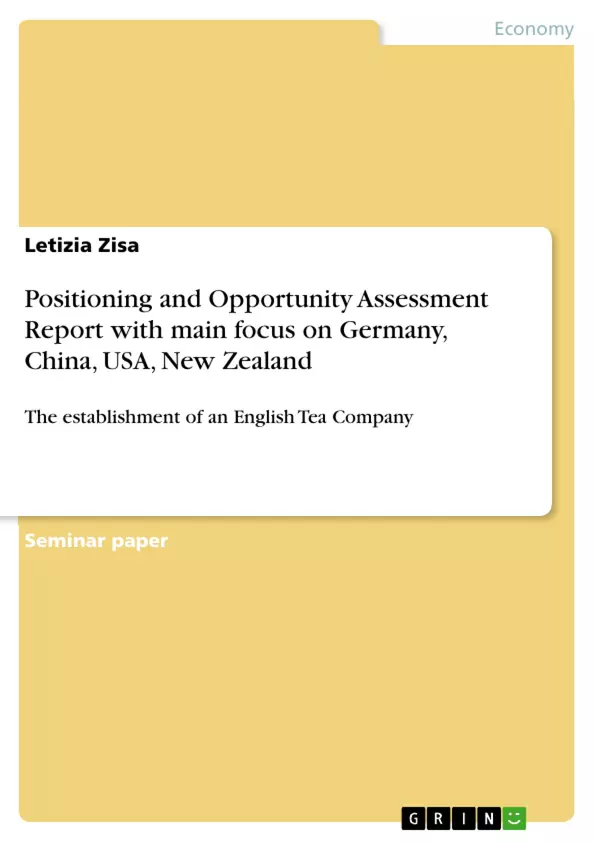PESTLE-framework
In order to analyse the macro environmental influences which have a considerable impact on Bettys, the English Tea Company located in the north east of England, it is economically reasonable to look at the PESTLE framework. This framework is a useful tool to understand the environment in which an organisation operates. Environmental influences never influence an organisation to the same extent, for some organisations any changes in the surrounding environment will pose a threat but for others those changes might be favourable. “Also, it will affect some organisations favourably whilst posing a threat to others” (Johnson,G., Scholes,K.,2002, p.102). The PESTLE- framework categorises the influences of the environment into six types: political, economic, social, technological, legal and environmental.
Market Entry Strategies - Entering a new market is always a critical and fundamental decision due to the advantages and disadvantages of each entry strategy, which will have an influence on the organisation's performance. “Furthermore, the choice of entry method will involve the firm in a long-term commitment from which it might find it hard to extricate itself without some cost.” (Chee,H., Harris, R.,1998, p. 292). According to Chee and Harris (1998, p. 291)
“(...) it is not a practical strategy to enter all markets with one single entry method; many large companies adopt multiple entry strategies (...)”.
Indirect Exporting - As illustrated in the graphics, indirect exporting involves the lowest risk factor when entering a foreign market. This is an ideal strategy for companies that have not got any contacts to the foreign market. Bettys could sell its products to an intermediary in Yorkshire, who himself then sells this products to the German market. The intermediary possesses the know-how and the resources that are necessary when entering a new market successfully.
Direct Exporting - Direct exporting allows Bettys to gain far more control about the international activities, however, the risk of failure is higher due to the costs in marketing, administration and distribution which the company has to absorb. One of the most common direct exporting strategies is franchising.
Direct Investment - Foreign direct investment is an opportunity for Bettys to become more actively involved in the international business activities. In its classic definition, FDI means investing into building a factory abroad
Inhaltsverzeichnis (Table of Contents)
- Part 1 Opportunity Assessment
- Glossary
- List of Figures
- Executive Summary
- Introduction
- Macro environment of international market
- PESTLE Framework
- Key Facts New Zealand
- Key Facts China
- Key Facts USA
- Key Facts Germany
- Market Segmentation by Industries
- New Zealand
- China
- USA
- Germany
- Geographical Variables – Businesses Portfolio Matrix
- Competitor Analysis
- Recommendation
- Part 2 Market Entry Strategy
- Market Entry Strategies
- Indirect Exporting
- Direct Exporting
- Direct Investment
- Cooperate Strategies
- Joint Ventures
- Strategic Alliances
- Marketing Plan
- Market Entry Strategy for Bettys
- Market Entry Strategies
- Part 3 Implementation of Bettys Marketing Mix
- Company Analysis - SWOT
- Marketing Mix
- Product
- Price
- Place
- Promotion
- Stimulus Response Model
- Bettys in Germany
- Conclusion
Zielsetzung und Themenschwerpunkte (Objectives and Key Themes)
This report provides guidance in developing an overseas positioning strategy for Bettys and Taylors of Harrogate Limited (Bettys) by investigating four potential markets: New Zealand, China, USA and Germany. The main objective is to identify the most suitable market for Bettys' expansion.- Market analysis using the PESTLE framework to assess macro-economic environments
- Market segmentation by industry, focusing on the hot drinks sector
- Competitor analysis using Porter's five forces model
- Evaluation of market entry strategies, including direct and indirect exporting, direct investment, and cooperative strategies
- Assessment of the feasibility and effectiveness of marketing mix strategies in the chosen market
Zusammenfassung der Kapitel (Chapter Summaries)
- Part 1 Opportunity Assessment explores the potential of four international markets for Bettys. It applies the PESTLE framework to analyze each country's macro-economic environment, focusing on political, economic, social, technological, legal, and environmental factors. The chapter also provides a market segmentation analysis by industry, examining the demand for hot drinks in each market. Additionally, it utilizes Porter's five forces model to analyze the competitive landscape for Bettys in each market. Finally, the chapter offers a recommendation on the most promising market based on the analysis.
- Part 2 Market Entry Strategy delves into various options for entering the chosen market. It discusses different market entry strategies, including indirect exporting, direct exporting, direct investment, and cooperative strategies like joint ventures and strategic alliances. The chapter then outlines a potential market entry strategy for Bettys, taking into account the specific characteristics of the chosen market and the company's objectives.
- Part 3 Implementation of Bettys Marketing Mix focuses on the practical aspects of implementing Bettys' marketing strategy in the chosen market. It conducts a SWOT analysis to identify the company's strengths, weaknesses, opportunities, and threats. The chapter then analyzes the components of the marketing mix: product, price, place, and promotion. It also examines the stimulus-response model to understand consumer behavior and the effectiveness of marketing efforts. Finally, the chapter discusses Bettys' specific market entry strategy for Germany, highlighting key considerations for implementing the marketing mix.
Schlüsselwörter (Keywords)
This report focuses on the international expansion of Bettys and Taylors of Harrogate Limited, utilizing market analysis, competitor analysis, and market entry strategy frameworks. Key terms include: PESTLE framework, market segmentation, Porter's five forces model, hot drinks market, market entry strategies (indirect exporting, direct exporting, direct investment, joint ventures, strategic alliances), marketing mix (product, price, place, promotion), SWOT analysis, stimulus-response model, and Germany as a potential target market.- Citation du texte
- Letizia Zisa (Auteur), 2010, Positioning and Opportunity Assessment Report with main focus on Germany, China, USA, New Zealand, Munich, GRIN Verlag, https://www.grin.com/document/171404



